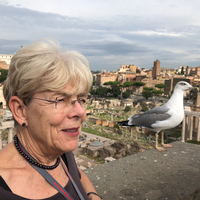Papers by Elzbieta Jastrzebowska

The House of Aion in Nea Paphos: seat of an artistic synodos?
The article presents some archaeological observations based on recent publications and the author... more The article presents some archaeological observations based on recent publications and the author’s survey in situ of the so-called “House of Aion” at Nea Paphos in Cyprus. The archaeological context (coins and pottery) dates the last phase of this building to the 320s, its partial destruction to the earthquake of 332/342, and its final annihilation by another quake to 365. The much-discussed mosaic with mythological decoration in the triclinium and the newly analyzed wall paintings in one of the rooms (No. 7), preserving the figures of Apollo and three of the Muses, are typical decorative elements of late antique Roman elite houses. And yet, the layout of the building, the triclinium located at the entrance to the house, and the presence of two rooms with a wooden floor, laid over an earlier water cistern converted into a cellar, possibly a treasury, suggest that the function of the complex was not residential at all. Indeed, the close proximity of the “Villa of Theseus”, which was rebuilt in the same period and converted into the praetorium of the governor of the island in the first half of the 4th century, suggests that the so-called “House of Aion” could have been the seat of a Roman association, probably a synodos of Dionysiac artists (ex-technitai) who presented themselves in the theater of Paphos. Therefore, it would be better to call this building the Synodeion of Late Roman Cyprus.
Daniel sur un fragment de mensa du Vieux Dongola
Solar Obelisks in Antique and Christian Rome
Kwartalnik Historii Kultury Materialnej, 2004
Les sarcophages chrétiens d’enfants à Rome au IVe siècle
... féminin du Musée national de Rome [R 803], sur cinq fragments de sarcophages, trop petits ...... more ... féminin du Musée national de Rome [R 803], sur cinq fragments de sarcophages, trop petits ... DEICHMANN Zur Erscheinung des Sternes von Bethlehem dans Vivarium Festschrift Theodor Klauser JbAC ... D'autres scènes bibliques sur le sarcophage de Berlin, bien connues dans l ...
Das antike Erbe in der Ikonographie der Kindheitsevangelien Christi

Słoneczne obeliski w Rzymie antycznym i chrześcijańskim Wśród dwunastu obelisków Rzymu-największe... more Słoneczne obeliski w Rzymie antycznym i chrześcijańskim Wśród dwunastu obelisków Rzymu-największej liczby takich obiektów zgromadzo nych w jednym miejscu-pochodzących z Egiptu, tak z okresu faraońskiego, jak i rzymskie go, zaledwie trzy i to największe zostały sprowadzone do stolicy Cesarstwa specjalnie w celu postawienia ich w cyrkach, pośrodku areny, na spinie, wokół której ścigały się rydwany1. Dwa inne obeliski trafiły też, na krótko, w III i na początku IV w. do cyrków Rzymu, ale nie był to pierwotny cel ich sprowadzenia, ani wystawienia. Ponadto jeszcze inna para obelisków stanowiła dekorację mauzoleum cesarskiego, a największą i dość jednorodną grupę tworzą mniejsze obeliski, dekorujące niegdyś świątynię Izydy i Serapisa. Obecnie wszystkie te gra nitowe pomniki stoją na różnych placach Rzymu, na które trafiły dzięki pasji archeologicznej i trosce konserwatorskiej kilku papieży z czasów nowożytnych od XVI po XX wiek (ryc. 1). Modę na sprowadzanie obelisków znad Nilu nad Tybr zapoczątkował August między 27 a 10 r. p.n.e.2 Przeniósł on z Heliopolis do Rzymu dwa ogromne obeliski wykute w granicie assuańskim3. Pierwszy z nich, mierzący 21,79 m długości, pierwotnie wzniesiony w Heliopo lis-świętym mieście boga Słońca Re-Harakte-przez Psametyka II (594-588 p.n.e.), posłużył w Rzymie jako gnomon zegara słonecznego, słynnego Horologium Augusti na Polu Marsowym, gdzie był odnotowany przez pielgrzymów jeszcze w VIII w.4 Potem silnie znisz czony, ponownie odkryty w 1748 r. i złożony z pięciu fragmentów został ustawiony w 1792 r. za pontyfikatu Piusa VI (1775-1799) (ryc. 2) nieopodal swojego pierwotnego miej sca ustawienia, na Piazza Montecitorio (przed dzisiejszą siedzibą parlamentu włoskiego).

In der christlichen Kunst des ersten Jahrtausends gibt es keine andere Darstellung, die derart si... more In der christlichen Kunst des ersten Jahrtausends gibt es keine andere Darstellung, die derart sinnbild lich die Wende des Heidentums zum Christentum manifestiert wie die Szene von der Anbetung der Magier. Diese Szene gehört auch zu den bekanntesten und am meisten untersuchten Szenen der christli chen Ikonographie. Da Hugo Brandenburgs Interesse stets der Wende des Heidentums zum Christen tum galt, er darüber hinaus bereits vor Jahren meine Aufmerksamkeit auf die Aisengemmen (wovon sich übrigens vier Stücke im Domschatz zu Münster befinden) lenkte, sind genügend Gründe gegeben, dem Jubilar zu Ehren diesem Thema noch einige Überlegungen zu widmen 1. Die Anbetung der Magier taucht erst am Anfang des 4. Jhs. in der christlichen Ikonographie in der Katakombenmalerei und auf Sarkophagreliefs auf 2. Dargestellt ist das neutestamentliche Ereignis, das im Matthäusevangelium (2,1 12), im Protevangelium des Jakobus (21,13, aus der zweiten Hälfte des 2. Jhs.) 3 und im Pseudo Matthäus (17,15, aus dem 4./5. Jh.) beschrieben wurde: "Transacto autem secundo anno, uenerunt magi ab Oriente interrogabant ludaeos dicentes: Vbi est rex qui natus est nobis? Vidimus enim stellam eius in Oriente et uenimus adorare eum. (...) Euntibus autem magis in uia apparuit Stella et quasi ducatum praestaret Ulis, antecedebat eos quousque peruenirent ubi erat puer. Videntes autem stellam magi quasi sunt gaudio magno et ingressi inuenerunt infantem lesum sedentem in sinu Mariae. Tunc aperuerunt thesauros suos et ingentibus muneribus singuli singulos aureos. Vnus optulit aurum, alius thus, tertius uero myrram" 4. Die Anbetung der Magier wurde in der frühchristlichen Literatur oft erwähnt (seit Ignatius von Antio chien), zuerst hauptsächlich zu "apologetischen Zwecken", dann mit "einer innerkirchlichtheologischen Auslegung" 5. Am theologischen Gehalt dieser Szene scheint jedoch bei den Kirchenvätern wenig ge deutet zu werden. Weder in den Evangelien noch in den patristischen Texten wird beschrieben, wie die Magier ausgesehen, wie sie ihre Gaben dargebracht haben und auf welche Weise die Anbetung ver laufen ist. Nur die Gaben wurden symbolisch bewertet: Myrrhe "für das sterbliche Geschlecht des Menschen", Gold für den König und Weihrauch für den Gott 6. Die verschiedenen Darstellungen dieses Ereignisses kamen der Schilderung des PseudoMatthäus am nächsten, wonach die Magier erst zwei Jahre nach der Geburt Christi gekommen sind, was nicht un 1 Zu den münsteraner Aisengemmen vgl. P. Pieper, Der Domschatz zu Münster (1981) Nr. 41-42; M. Schulze-Dörrlamm, Bemerkungen zu Alter und Funktion der Aisengemmen, AKorrBl 20, 1990, 223 f. Nr. 13. 26. 2 Vgl. vor allem H. Kehrer, Die Heiligen Drei Könige in Literatur und Kunst 1 (1908); G. Vezin, L'adoration et le cycle des mages dans l'art chretien primitif (1950); J. Deckers, Die Huldigung der Magier in der Kunst der Spätantike, in: Die Heiligen Drei Könige. Darstellung und Verehrung (1982) 20-32; E. Jastrzebowska, Bild und Wort. Das Marienleben und die Kindheit Jesu in der christlichen Kunst vom 4. bis zum 8. Jh. und ihre apokryphen Quellen (1992) 8-10. 110-113. 168-192. 3 E. Hennecke-W. Schneemelcher, Neutestamentliche Apokryphen (1989) 347 f. 4 J. Gijsel, Die unmittelbare Textüberlieferung des sog. Pseudo-Matthäus (1981), Anhang nach dem Codex Remensis von 1395; vgl. auch Jastrzebowska a.O. 111. 5 E. Dassmann, Sündenvergebung durch Taufe, Buße und Märtyrerfürbitte in den Zeugnissen frühchristlicher Frömmigkeit und Kunst (1973) 316-322; vgl. auch Deckers a.O. 22 f.

Une amulette de Chersonèse Taurique avec Salomon terrassant la démone femelle : inscription énigm... more Une amulette de Chersonèse Taurique avec Salomon terrassant la démone femelle : inscription énigmatique En 1983, au quartier nord de Chersonèse Taurique, dans la cave d'une maison, datée des XII-XIII e siècles, on a trouvé une amulette de bronze, en forme de médaille, de 4,8 cm de diamètre. Elle porte des deux côtés des représentations figurées en relief, accompagnées de légendes sur le pourtour 1. Son bord, en haut, était à l'origine percé d'un trou rond de suspension, mais aujourd'hui le bord dans ce point est abîmé. À côté, il y a un autre trou, plus petit, fait probablement plus tard dans le même but, ce qui peut signifier que l'amulette était longtemps en usage. La décoration en relief est très schématisée, linéaire, les figures sont à peine lisibles. L'avers de l'amulette montre un cavalier nimbé tourné vers la droite. Il porte un costume militaire avec un paludamentum flottant derrière son dos 2. Dans la main droite il tient une lance à hampe cruciforme (elle n'est conservée qu'à ses bouts) et, de la main gauche, qui est invisible, il tient la bride du cheval. Devant le cheval, par terre, une femme est allongée sur le dos (tournée vers la droite), elle porte une jupe longue et plissée, sa poitrine est nue et la lance du chevalier la transperce. Un ange nimbé, vêtu d'une tunique longue et d'un manteau, précède le cavalier. Lui aussi, il se dirige à droite, son aile gauche est abaissée, tandis que l'aile droite, ouverte, semble se soulever. Avec sa main droite abaissée, l'ange indique le chemain au chevalier. Sur le pourtour, une légende qui est peu déchiffrable (l<S>]eiïye)i?,\iia%nbfi 2,[oXo]ii&v CTB ôWKI /c(at)âyyeXoç Mpà [<x<p] 3) accompagne cette représentation. Le revers de l'amulette porte aussi une légende peu lisible sur le pourtour : + Miyar\ Ta.ppir\X 0'vpir\X PacpariX pofjOi TOô q>opov-v{z\i*, et une autre représentation figurée en deux registres, qui ne sont pas pourtant séparés. En haut, on voit deux grands bustes affrontés : à gauche le soleil avec une couronne radiée, et à droite la lune avec le croissant sur sa tête 5. Au milieu de ces bustes se trouve un simple médaillon rond avec une croix inscrite. En bas, il y a un lion bondissant à droite au dessus d'un serpent et, tous les deux, ils terrassent une femme étendue par terre, représentée de la même façon, mais plus schématiquement, que sur l'avers. Le lion se précipite vers un grand mauvais oeil, représenté à droite en diagonale. Au dessus du lion, on voit les lettres latines : RPS, et plus à droite, entre le lion et l'oeil, les lettres SS.
Olimp schrystianizowany: Ikonografia dwóch obrazów w Zamku Królewskim w Warszawie
The paper discusses a number of examples of the cross motif on architectural elements from Late A... more The paper discusses a number of examples of the cross motif on architectural elements from Late Antique and Byzantine Ptolemais, Libya. The cross was one of the most frequent, if not exclusive decorative motifs used in Ptolemais, both in churches as well as public and private buildings. In the churches, crosses were placed in visible places, on the arcades crowning the apse or separating the nave from the aisles, on pillars and columns, and finally, on marble altar screens. In private houses, the cross motif constituted a decorative form of religious identification practiced by the inhabitants; the same function, but in more modest terms, was served by cross representations found in public buildings.
The article discusses an ancien mai ^ Helena Radziwill The capital wasfirst published Masowia. th... more The article discusses an ancien mai ^ Helena Radziwill The capital wasfirst published Masowia. that until 1820s belonged to t ie p> mcc author however argues for its dating to the second in 2001 and dated to the 3rd-4th cent. Constantmople. Ravenna, Rome. Venice and halfof the 5th cent., pointing to snnilar Cor P , that jt orjgjnally topped a free-standing Chersonesus. The capital's dimensions (lower di ■) ® Petersburg at the turn of the 18th (honorific ?) column. 1t is likely to have been hrought to Arkactia and 19th centuries. In den 70-er Jahren des vergangenen Jahrhunderts wurde im Park Arkadia bei Nieboröw (ca^ 50 jan westlich von Warschau) ein Marmoikapitell (nv.

DANIEL I TEKLA MIĘDZY LWAMI: ANTYCZNE KORZENIE SCENY chrześcijańskich tekstach hagiograficznych, ... more DANIEL I TEKLA MIĘDZY LWAMI: ANTYCZNE KORZENIE SCENY chrześcijańskich tekstach hagiograficznych, już we wczesnych actamartyrum, ale zwłaszcza w późniejszych żywotach i legendach świętych, częste są postacie czcigodnych mężów i niewiast, którzy w najrozma itszy sposób mieli do czynienia z jednym lwem lub z ich parą. Wystarczy wspo mnieć tu Darię, nawróconą przez Chrysanta, skazaną na pobyt w domu nierządu dziewicę chrześcijańską, do której dostępu bronił lew 1. Równą, a nawet jeszcze większą sławą cieszyła się, rzucona ad bestias w amfiteatrze antiocheńskim, mę czennica Tekla, której ani lew, ani lwica, ani inne tam wypuszczone i zgłodniałe zwierzęta drapieżne nie tylko nie tknęły, ale jej kornie oddały cześć 2. Mniej zna ny jest natomiast Malchus z Nisibis, którym opiekowała się cała lwia rodzina 3 , zaś legendarna przyjaźń św. Hieronima z lwem bywa przytaczana przy różnych sposobnościach po dziś dzień. Jednakże wśród "lwich świętych" najpowszechniejsze stały się postacie biblijne, i to zarówno pogromcy lwów Samson oraz Dawid, jak i prorok Daniel adorowany przez lwy, czy wreszcie ci, których lew symbolizował, jak patriarcha Juda lub ewangelista Marek, by wspomieć wreszcie samego Chry stusa stojącego na lwie, który w tym przypadku był uosobieniem zła. porównaniu z tak licznymi tekstami biblijnymi i bogobojnymi opowieścia mi literackimi, w których występują lwy wraz z całą rozwiniętą w chrześcijań skich źródłach pisanych symboliką lwa, najstarsza ikonografia chrześcijańska czczo nych postaci z lwami przedstawia się nader skromnie 4. Dopiero znacznie późniejsza '
Embolos. Reprezentacyjna ulica Efezu we wczesnym i późnym Cesarstwie
Zastyganie antyku i spirytualizm chrześcijański : Wystawa w Metropolitan Museum of Art w Nowym Jorku listopad 1977 — luty 1978
La bottega del tagliapietre a Tolemaide











Uploads
Papers by Elzbieta Jastrzebowska